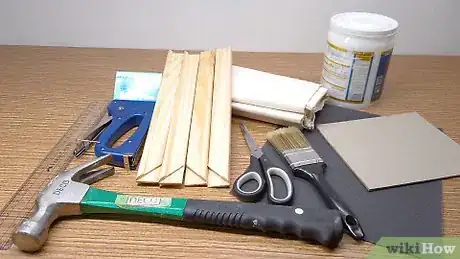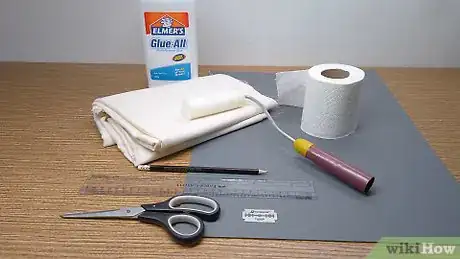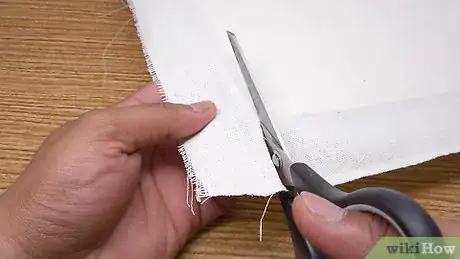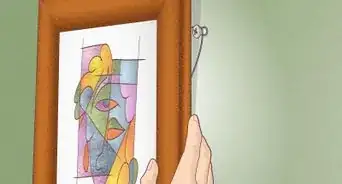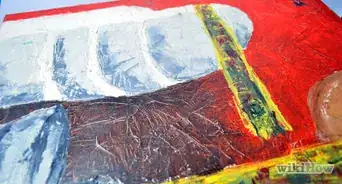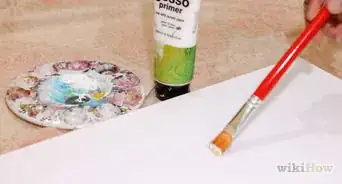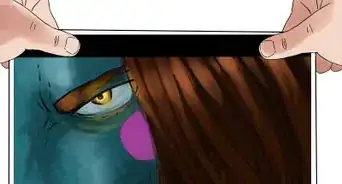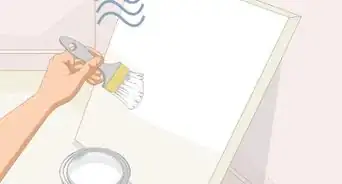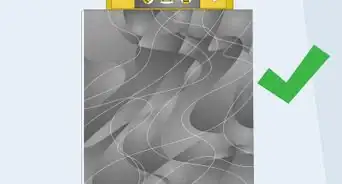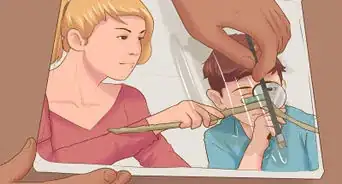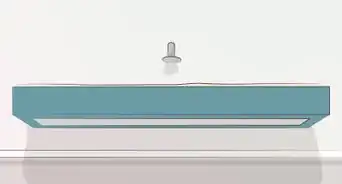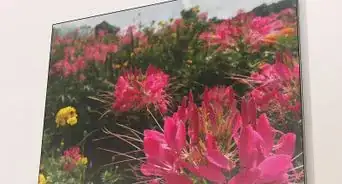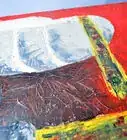This article was co-authored by Kelly Medford. Kelly Medford is an American painter based in Rome, Italy. She studied classical painting, drawing and printmaking both in the U.S. and in Italy. She works primarily en plein air on the streets of Rome, and also travels for private international collectors on commission. She founded Sketching Rome Tours in 2012 where she teaches sketchbook journaling to visitors of Rome. Kelly is a graduate of the Florence Academy of Art.
This article has been viewed 191,140 times.
Making your own canvas panels can be a very satisfying project for any artist. Not only is your work showcased on the canvas, but your work is also the panel itself. This project is simple enough to create numerous panels at a time at a fraction of the cost of buying pre-made canvas panels. Simply gather the correct materials, set aside some time, and you will soon be on your way to making your own canvas panels!
Steps
Using a Wood Frame
-
1Gather your supplies. Artist Kelly Medford emphasizes that the most important things you need are, "canvas—I buy it in rolls—and the stretcher bars, [which] you put together [yourself]." In total, you will need the following supplies. You can find these supplies at your local art store. [1]
- A long piece of art canvas. You should get a canvas that is long enough to create your ideal canvas size.
- Four stretcher bars. These are wooden bars that have notches on one end. You should get two stretcher bars that are the ideal width you want for the canvas and two stretcher bars that are the ideal height you want for the canvas, for example, 16 x 24 or 11 x 15.
- A hammer.
- A staple gun.
- A pair of scissors.
- Acrylic based gesso.
- A paintbrush.
- Sandpaper.
- Palette paper.
-
2Fit the stretcher bars together. Take one long stretcher bar and one short stretcher bar. Slide the notched ends of the stretcher bars together, pushing with your hands until the two ends side together. They should be flush with each other, forming a diagonal line where the two ends meet.[2] Artist Kelly Medford suggests "holding each corner in a door frame and making sure it's square. The bigger it gets, the more challenging it is to get it right," and the more important it is to double check straightness.
Repeat this with the two remaining stretcher bars until you have built a wooden frame composing of all four stretcher bars.
Advertisement -
3Tap the sides lightly with the hammer. To ensure the sides of the canvas are fitted properly and securely, you can use the hammer to tap the sides. Do this on the outside of the wooden frame and tap lightly so the ends are firmly joined together.[3]
-
4Cut the canvas to fit the wood frame. Spread the canvas out on a flat surface, such as a table. Then, place the wooden frame on top of the canvas. Gently fold the canvas so it covers the length of the wooden frame and the ends fold over the wooden frame so the stretchers are covered by the canvas.[4] Artist Kelly Medford recommends using a stretching tool, "which is like pliers that you pull the canvas over the stretcher bar with." This can help you get a tighter stretch.
Use the scissors to make a cut and then use your hands to tear the canvas so the excess canvas comes off. Do this by holding down one half of the canvas and tearing the excess canvas off at an angle. Repeat this on the other side of the wooden frame until the canvas fits the wooden frame.
-
5Attach the canvas to the frame. Use the staple gun to attach the canvas to the frame. Fold over one short side of the canvas so it covers the stretcher bar and then staple the canvas to the stretcher bar. Place one staple on one end, one staple in the centre, and one on the other end for a total of three staples.[5] Alternatively, artist Kelly Medford notes that you can use a hammer and nails: "I [use those] because they're actually really easy to pick out. If you're stretching it and it gets lopsided, I find it really easy to take nails out and restretch it. Also because a lot of times I travel, I have to ship paintings and roll them—it's really easy to unstretch and restretch them with nails rather than staples."
- Rotate the frame and pull the canvas very tightly on the opposite end. Then, attach the canvas to the other short side of the canvas with three staples. Leave the centre staple for last. Artist Kelly Medford notes that you can also use this technique if you are using a hammer and nails: "put one nail on each side and work your way out from the center towards the end, continually rotating each side while you're doing it, so that way you should be pulling it evenly. Then, if you get really big bubbles or bumps as you're going, you can just take one nail out and redo it."
- Turn the frame to the longer side. Fold the canvas over the frame. You will notice a notch of canvas that sticks out when you fold the canvas over the frame. Use your index finger to gently push in this notch so it tucks into the fold. Then, pull the canvas up as tight as possible and push it down over the frame. Attach the canvas to the frame with a staple over the folded corner.
- Repeat these steps for the other corner, making sure to push down the notch, pull the canvas tightly and fold it over. Secure the canvas with a staple.
- Finish attaching the rest of the canvas to the frame by pulling tightly on the canvas and staple it down. You can put six staples on the longer ends of the canvas to ensure it is secure.
-
6Prime the canvas. To make the canvas smooth, tight, and ready for painting, you will need to prime it. Do this by applying acrylic based gesso to the canvas so it dries stiff and taunt.[6]
- Start by shaking up the acrylic based gesso. Then, pour the gesso onto a sheet of palette paper.
- Use the paint brush to paint the entire area of the canvas. You should do one thick coat of the paint, making sure to get the sides of the canvas as well.
- Let the gesso dry. Then, use the sandpaper to sand the canvas. Sand the canvas using small, circular motions. Do one layer of sanding on the canvas and don't worry too much about making it very smooth.
- After one sanding session, pour gesso onto the palette paper and use the brush to add another layer of gesso to the entire canvas. You can use a hair dryer to dry the gesso faster.
- Once the gesso is dry, sand the canvas one more time. Try to make the canvas really smooth. After a good sanding, the canvas is ready for use.
Using a Board
-
1Gather your materials. You will first need to purchase either non-buckle board, masonite, hard board, or birch plywood. The first can be found at your local arts and crafts store and is traditionally labeled Gator Board. The latter three can be found at your nearest hardware store. You will need 1/2 inch thick panels. The dimensions of the board should be the size you wish your painting to be. If you can only buy pre-cut panels, make sure to get one larger than your final project. You will also need:
- Linen or cotton canvas material. This usually comes in rolls and can be found at arts and crafts stores. A typical precut canvas size is a 21 inch (53.34 cm) height x 50 inch (127 cm) width roll of canvas, which will give you two 20 inch x 24 inch (50.8 cm x 60.96 cm) canvas panels.
- Miracle Muck Glue
- Rotary blade and/or scissors
- Ruler
- Pencil
- Rubber paint roller
- Heavy rubber roller
- Paper towels
- Sand paper
- Rotary saw (for masonite, hard board, and/or birch plywood)
- Brown wrapping paper
-
2Cut the board to your desired dimensions. This is only if the sheet of board you bought was pre-cut, and therefore larger than your final project. First measure out, using a ruler and pencil, the dimensions of your board. You can draw lines directly onto the board. Try and make sure to use the back of the board, this way pencil lines won't appear on the front. When you are done you should have a rectangular shape outlined on the board.[7] [8]
- If your board is non-buckle board such as Gator Board, use a rotary blade to cut along the lines you drew.
- If your board is masonite, hard board, or birch plywood, you will need to use a rotary saw to cut it down to size. Cut along the lines that you drew on the board.
- Make sure that you are in a safe area, such as outside or in your construction garage. Always wear goggles when cutting, and make sure that your hands do not get near the blade.
- No matter what board you are using, after it is cut, sand the edges down gently so that they are smooth.
-
3Place the canvas material underneath the board. Outline a blueprint to cut along, approximately 1 inch (2.54 cm) longer than the board on each side. You can do this with a simple ruler and pencil. If your canvas material has two sides (one for show, one for backing) make sure you are drawing pencil lines on the side meant for backing. Lift away your canvas.[9] [10]
- For example, if your board is 20 X 30 inches, the rectangle you draw onto the canvas should be 22 X 32 inches.
- Cut the rectangle out with either a pair of scissors or a rotary blade. If you use a rotary blade, make sure that you are cutting on top of a safe surface such as a cutting board.
-
4Glue the canvas and board. Take some of your Miracle Muck Glue (or off brand) and pour it onto the middle of the canvas sheet (middle of the drawn rectangle). Take out your rubber paint roller and begin spreading it around the sheet. Try your best to keep the glue contained within the drawn rectangle.[11] [12]
- Then pour some glue onto the middle of one side of your board. Take the same roller and begin to spread it around. The corners and edges are especially important.
- The glue spread over both surfaces should be a relatively thin layer. Do not pour too much otherwise it will ooze out the sides when you place them together.
-
5Combine the canvas and board. Take your board and flip it over. Press the glued side of the board against the glue side of the canvas (on table, facing up). Line up the board as best you can with the drawn rectangle on the canvas. Then, take your heavy roller out and begin to run the roller against the board. This will get the air bubbles out that are likely to be present between the canvas and board.[13] [14]
- While you are rolling the board, you may have to readjust the board as it might slide.
- After you have rolled against the board, press down with your hands. Place one hand overtop of one another and apply pressure firmly and evenly throughout. This will further secure the board to the canvas.
-
6Put books on top of your board. Place two heavy books side-by-side on top of your canvas so that they cover the entire space. Then begin to stack other books on top of them. You can even add other heavy objects such as paper weights to the top of your pile. This pressure needs to be created in order for the canvas to seal with the board.[15] [16]
- If you have not already done so, transfer this pile to a safe location. This should be somewhere where there is not a lot of movement going on. Do not place this near a children's play space. The best place is a basement, or a secluded room.
- Your canvas will need an entire day to properly dry and set. The following day (after 24 hours) you can remove the books/weights.
-
7Cut the corners of the canvas material (option 1). Do so by cutting a diagonal slice into the canvas in line with each corner of the board. Then fold each side of the slice so they are lying on top of each other in a perpendicular manner. One option to get them to remain pulled back is to apply some super glue to the underside of the canvas edges. Then press each edge, one at a time, against the edge of the board. Hold each edge for at least 1 minute.
- If you use the glue method, make sure that the glue is spread evenly over the entire strip so that it does not begin to peel away.
- The second method is to use sewing pins. Curve your edges backwards and stick two to three pins on each side, through the canvas and into the board. This method only really works on Gator Board; however, you can try to tick the pins into a harder surface.
-
8Trim the excess fabric (option 2). Take your rotary blade and cut the canvas as close to the board as you can possibly get it. Make sure that you are cutting on a safe surface such as a cutting board. Depending on the thickness of the canvas you may have to pass over the same area multiple times in order to cut it.[17] [18]
-
9Create a backing for your canvas. Outline and cut a sheet of brown wrapping paper about 1/2 inch (1.27 cm) shy of the actual size of the mounted canvas on each side. For example, if your mounted canvas is 20 X30 inches, the brown wrapping paper should be 19 1/2 X 29 1/2 inches. Simply use a ruler to measure the edges, and draw out the dimensions onto the paper using a pencil. Then cut with either scissors or a rotary blade.
-
10Attach the backing to your canvas. Make sure that the canvas fabric is facing down. First, pour some Miracle Muck Glue onto the back of the board. Spread it out evenly using your paint roller. Then take your brown wrapping paper and press it against the glued board. Use your heavy roller and roll against the brown paper. Make sure that there are no air bubbles left over.[19] [20]
- Put two heavy books on top of the brown paper so that they cover the entire space. Put other heavy books and/or objects on top of those two books.
-
11Allow the canvas to dry. The canvas should once more be kept in a safe space. Wait 24 hours before you remove the books and/or objects. Once the canvas is dry, it is ready for use.
Community Q&A
-
QuestionCan I use any fabric?
 Community AnswerCanvas is usually linen. You can experiment with cotton, silk, leather, velvet and other fabrics, but they will hold paint differently.
Community AnswerCanvas is usually linen. You can experiment with cotton, silk, leather, velvet and other fabrics, but they will hold paint differently. -
QuestionWhich color I should use for a canvas?
 Community AnswerYou can use any color you would like. However, it is best if you choose a color similar to the canvas if you have a colored canvas. For example, if you had a yellow canvas, you should use more reds and oranges instead of purples.
Community AnswerYou can use any color you would like. However, it is best if you choose a color similar to the canvas if you have a colored canvas. For example, if you had a yellow canvas, you should use more reds and oranges instead of purples. -
QuestionIs it really important to apply white paint to a canvas before painting on it?
 Community AnswerIt's the most common color to prime with! Usually gesso is already white, so that's that. If you don't want to prime with white, most people choose a warm or cool color to complement the painting's atmosphere.
Community AnswerIt's the most common color to prime with! Usually gesso is already white, so that's that. If you don't want to prime with white, most people choose a warm or cool color to complement the painting's atmosphere.
Warnings
- Anything larger than a 20 inch x 24 inch (50.8 cm x 60.96 cm) canvas panel has a higher risk of warping, so try to stay around this size when making your own.⧼thumbs_response⧽
- If you get any glue on your hands, make sure to immediately wash your hands with warm water and soap.⧼thumbs_response⧽
References
- ↑ https://www.youtube.com/watch?v=OmrPXnRRLVA
- ↑ https://www.youtube.com/watch?v=OmrPXnRRLVA
- ↑ https://www.youtube.com/watch?v=OmrPXnRRLVA
- ↑ https://www.youtube.com/watch?v=OmrPXnRRLVA
- ↑ https://www.youtube.com/watch?v=OmrPXnRRLVA
- ↑ https://www.youtube.com/watch?v=yP7PWtEATXU
- ↑ http://www.danschultzfineart.com/blog/want-to-make-your-own-plein-air-canvas-panels/
- ↑ https://www.oilpaintersofamerica.com/2013/05/making-your-own-linen-panels/
- ↑ http://www.danschultzfineart.com/blog/want-to-make-your-own-plein-air-canvas-panels/
- ↑ https://www.oilpaintersofamerica.com/2013/05/making-your-own-linen-panels/
- ↑ http://www.danschultzfineart.com/blog/want-to-make-your-own-plein-air-canvas-panels/
- ↑ https://www.oilpaintersofamerica.com/2013/05/making-your-own-linen-panels/
- ↑ http://www.danschultzfineart.com/blog/want-to-make-your-own-plein-air-canvas-panels/
- ↑ https://www.oilpaintersofamerica.com/2013/05/making-your-own-linen-panels/
- ↑ http://www.danschultzfineart.com/blog/want-to-make-your-own-plein-air-canvas-panels/
- ↑ https://www.oilpaintersofamerica.com/2013/05/making-your-own-linen-panels/
- ↑ http://www.danschultzfineart.com/blog/want-to-make-your-own-plein-air-canvas-panels/
- ↑ https://www.oilpaintersofamerica.com/2013/05/making-your-own-linen-panels/
- ↑ http://www.danschultzfineart.com/blog/want-to-make-your-own-plein-air-canvas-panels/
- ↑ https://www.oilpaintersofamerica.com/2013/05/making-your-own-linen-panels/
- Videos provided by artist rage
About This Article
To make a canvas, begin by fitting 4 stretcher bars together to form a rectangular frame and tapping the sides with a hammer to make sure the corners are firmly joined. Next, cut a piece of canvas down the the size of the frame with enough of a border to fold over the edges. Then, use a staple gun to attach the canvas to the frame, pulling the fabric tight around the edges so there are no wrinkles. Finally, prime the canvas for painting by applying 2 coats of gesso, sanding it lightly between layers. For tips on how to make a canvas using a board, read on!
